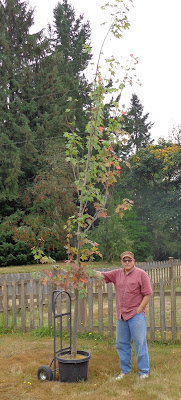This maple grew up in a border, at my house in Vancouver. No room there. I decided to move it to the place in Battleground.
This takes me back to when I was a boy. Often a neighbor or family member would have a volunteer tree, and give it away to someone who needed a shade tree. It's a nice memory. People should do that now. It would be neighborly, and promote successful, locally adapted species and varieties.
I guess most trees now are clones, grafted to seed-grown rootstocks. Then grown in field-nurseries. Then bare-rooted, shipped, and sold, or bare-rooted, shipped, and sold to big box stores or nurseries, to be resold. Nothing wrong with being a clone, but it means the tree is probably shipped from a distance, the variety or species may not be locally adapted. I've seen tropical species sold here. They won't survive. The lack of genetic diversity gives propensity for widespread disease, and loss of mature specimens, years later. I'm guessing that a tree on its own roots is more vigorous, but I don't know that.
I have also read, starting with a small tree, it will adapt quickly and surpass trees that were planted at much larger size. This tree is now plated about 25 feet from the red maple, we planted a few weeks ago. So we can have a "competition". Will the little tree catch up to the big one? Not a fair competition. They are not identical varieties. This little tree may or may not be a "red maple".
Acer rubrum. The leaves look more like red maple than Norway maple,
Acer platanoides. There is also
Acer macrophllum, the indigenous "Big Leaf" maple. This does not quite look like those, either. Time will tell.
As with other trees, I chose a generous distance from the tree and sliced vertically, making a circle around the tree. This is a small tree, about 3 feet tall. I think it sprouted from seed last year.
Continuing the circle. One side is a short, retaining, stone wall about one foot high. That made digging easier. I did not have to dig on that side.
Then the trench, dug farther from the tree. There didn't turn out to be much root. I don't think any roots were cut or broken. That will make for easier adjustment to its new environment. This area has been enriched with lots of compost. Digging was easy. It's been dry for most of the summer.
I placed the tree into a plant container for transport. I was not able to plant it last night. So I watered it thoroughly. Holes in the bottom prevented water-logging. No wilting at all. Looks as good as it did before digging.
Now in the ground. I've been reading, it's better to plant trees at slightly above ground level. That makes for better drainage. It may be an issue for compacted soils. This hole drained very quickly so it is not compacted. I usually plant bought trees at approximately ground level, as close as I can determine. It can be difficult to judge. It's not rocket science. This tree was "happy" choosing it's own level, so that's were I replanted it.
Filled in, watered, mulched with compost. Now we await fall.
















































